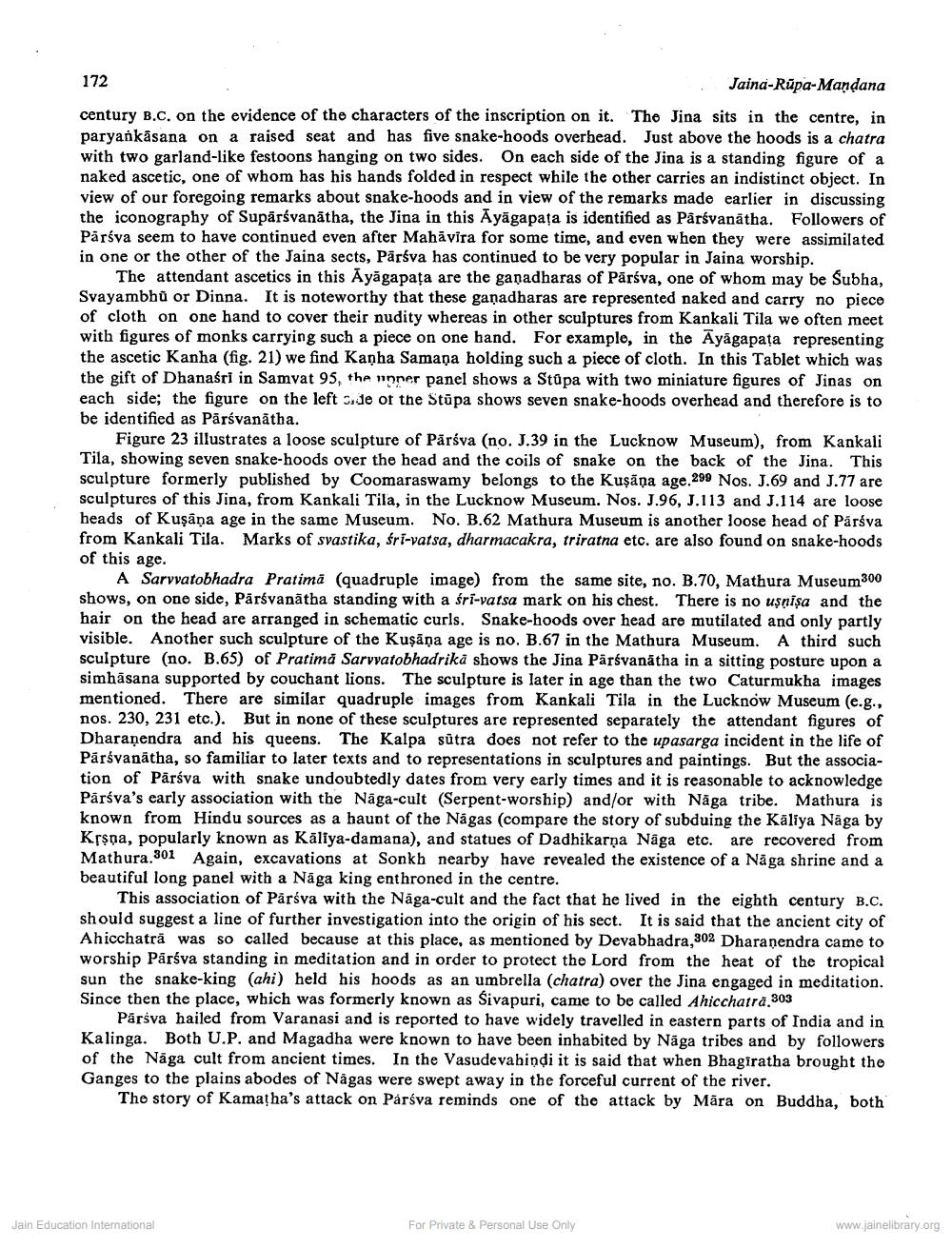________________
172
Jaina-Rupa-Mandana century B.C. on the evidence of the characters of the inscription on it. The Jina sits in the centre, in paryankäsana on a raised seat and has five snake-hoods overhead. Just above the hoods is a chatra with two garland-like festoons hanging on two sides. On each side of the Jina is a standing figure of a naked ascetic, one of whom has his hands folded in respect while the other carries an indistinct object. In view of our foregoing remarks about snake-hoods and in view of the remarks made earlier in discussing the iconography of Supārsvanatha, the Jina in this Ayāgapata is identified as Pārsvanatha. Followers of Parsva seem to have continued even after Mahavira for some time, and even when they were assimilated in one or the other of the Jaina sects, Pārsva has continued to be very popular in Jaina worship.
The attendant ascetics in this Ayāgapata are the ganadharas of Pärśva, one of whom may be Subha, Svayambhu or Dinna. It is noteworthy that these gañadharas are represented naked and carry no piece of cloth on one hand to cover their nudity whereas in other sculptures from Kankali Tila we often meet with figures of monks carrying such a piece on one hand. For example, in the Ayagapata representing the ascetic Kanha (fig. 21) we find Kanha Samana holding such a piece of cloth. In this Tablet which was the gift of Dhanasri in Samvat 95, the nnner panel shows a Stupa with two miniature figures of Jinas on each side; the figure on the left side of the Stūpa shows seven snake-hoods overhead and therefore is to be identified as Pārsvanātha.
Figure 23 illustrates a loose sculpture of Pārsva (no. J.39 in the Lucknow Museum), from Kankali Tila, showing seven snake-hoods over the head and the coils of snake on the back of the Jina. This sculpture formerly published by Coomaraswamy belongs to the Kuşāņa age.299 Nos. J.69 and J.77 are sculptures of this Jina, from Kankali Tila, in the Lucknow Museum. Nos. J.96, J.113 and J.114 are loose heads of Kuşāna age in the same Museum. No. B.62 Mathura Museum is another loose head of Parsva from Kankali Tila. Marks of svastika, fri-vatsa, dharmacakra, triratna etc. are also found on snake-hoods of this age.
A Sarvvatobhadra Pratima (quadruple image) from the same site, no. B.70, Mathura Museum 300 shows, on one side, Parsvanātha standing with a śrī-vatsa mark on his chest. There is no uşnişa and the hair on the head are arranged in schematic curls. Snake-hoods over head are mutilated and only partly visible. Another such sculpture of the Kuşāpa age is no. B.67 in the Mathura Museum. A third such sculpture (no. B.65) of Pratimă Sarvvatobhadriká shows the Jina Pärsvanātha in a sitting posture upon a simhasana supported by couchant lions. The sculpture is later in age than the two Caturmukha images mentioned. There are similar quadruple images from Kankali Tila in the Lucknow Museum (e.g., nos. 230, 231 etc.). But in none of these sculptures are represented separately the attendant figures of Dharanendra and his queens. The Kalpa sūtra does not refer to the upasarga incident in the life of Parsvanátha, so familiar to later texts and to representations in sculptures and paintings. But the association of Pärśva with snake undoubtedly dates from very early times and it is reasonable to acknowledge Pārsva's early association with the Näga-cult (Serpent-worship) and/or with Nāga tribe. Mathura is known from Hindu sources as a haunt of the Nagas (compare the story of subduing the Kaliya Naga by Krsna, popularly known as Kāliya-damana), and statues of Dadhikarņa Naga etc. are recovered from Mathura.301 Again, excavations at Sonkh nearby have revealed the existence of a Näga shrine and a beautiful long panel with a Nāga king enthroned in the centre.
This association of Parśva with the Näga-cult and the fact that he lived in the eighth century B.C. should suggest a line of further investigation into the origin of his sect. It is said that the ancient city of Ahicchaträ was so called because at this place, as mentioned by Devabhadra 302 Dharanendra came to worship Pärśva standing in meditation and in order to protect the Lord from the heat of the tropical sun the snake-king (ahi) held his hoods as an umbrella (chatra) over the Jina engaged in meditation. Since then the place, which was formerly known as Sivapuri, came to be called Ahicchatră.303
Parsva hailed from Varanasi and is reported to have widely travelled in eastern parts of India and in Kalinga. Both U.P. and Magadha were known to have been inhabited by Nāga tribes and by followers of the Näga cult from ancient times. In the Vasudevahindi it is said that when Bhagiratha brought the Ganges to the plains abodes of Någas were swept away in the forceful current of the river.
The story of Kamatha's attack on Párśva reminds one of the attack by Mära on Buddha, both
Jain Education International
For Private & Personal Use Only
www.jainelibrary.org




